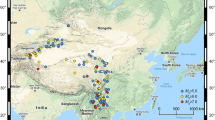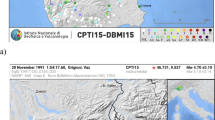Abstract
Macroseismic intensity data plays an important role in the process of seismic hazard analysis as well in developing of reliable earthquake loss models. This paper presents a physical-based model to predict macroseismic intensity attenuation based on 560 intensity data obtained in Iran in the time period 1975–2013. The geometric spreading and energy absorption of seismic waves have been considered in the proposed model. The proposed easy to implement relation describes the intensity simply as a function of moment magnitude, source to site distance and focal depth. The prediction capability of the proposed model is assessed by means of residuals analysis. Prediction results have been compared with those of other intensity prediction models for Italy, Turkey, Iran and central Asia. The results indicate the higher attenuation rate for the study area in distances less than 70km.
Similar content being viewed by others
References
Allen TI, Wald DJ, Hotovec AJ, Lin K, Earle PS and Marano KD (2008), “An Atlas of ShakeMaps for selected global earthquakes,” U.S. Geological Survey Open-File Report 2008-1236 47, Golden, USA.
Allen TI, Wald DJ, Earle PS, Marano KD, Hotovec AJ, Lin K and Hearne M (2009), “An Atlas of ShakeMaps and population exposure catalog for earthquake loss modeling,” Bull. Earthq. Eng., 7(3): 701–718.
Allen TI, Wald DJ and Worden CB (2012), “Intensity Attenuation for Active Crustal Regions,” Journal of Seismology, 16: 409–433.
Atkinson G and Kaka S (2007), “Relationship Between Felt Intensity and Instrumental Ground Motion in the Central United States and California,” Bull. Seism. Soc. Am., 97(2): 497–510.
Bakun WH (2006), “MMI Attenuation and Historical Earthquakes in the Basin and Range Province of Western North America,” Bull. Seism. Soc. Am., 96(6): 2206–2220.
Berberian M and Yeats R (1999), “Patterns of Historical Earthquake Rupture in the Iranian Plateau,” Bull. Seism. Soc. Am., 89(1): 120–139.
Bindi D, Parolai S, Oth A, Abdrakhmatov K, Muraliev A and Zschau J (2011), “Intensity Prediction Equations for Central Asia,” Geophys. J. Int., 187: 327–337.
Douglas J (2011), “Ground-Motion Prediction Equations 1964–2010,” Final report RP-59356-FR (PEER Report 2011/102), BRGM, Orléans, France, URL.
Eleftherriadou AK and Kariabinis AI (2011), “Development of Damage Probability Matrices Based on Greek Earthquake Damage Data,” Earthquake Engineering and Engineering Vibration, 10(1): 129–141.
Erdik M, Aydinoglu N, Fahjan Y, Sesetyan K, Demircioglu M, Siyahi B, Durukal E and Ozbey C (2003), “Earthquake Risk Assessment for Istanbul Metropolitan Area,” Earthquake Engineering and Engineering Vibration, 2(1): 1–23.
Faenza L and Michelini A (2011), “Regression Analysis of MCS Intensity and Ground Motion Spectral Accelerations (SAs) in Italy,” Geophys. J. Int., 186: 1415–1430.
Mak S, Clements RA and Schorlemmer D (2015), “Validating Intensity Prediction Equations for Italy by Observations,” Bull. Seism. Soc. Am., 105(6): 2942–2954.
Musson RMW (2005), “Intensity Attenuation in the UK,” Journal of Seismology, 9: 73–86.
Pantea A (1994), “Macroseismic Intensity Attenuation for Crustal Sources on Romanian Territory and Adjacent Areas,” Natural Hazards, 10(1): 65–72.
Siahkali A, Mirzaei N and Rezapour M (2004), “Attenuation Relationships of Seismic Intensity in Iran,” J. Earth & Space Physics, 30(1): 31–37.
Sørensen MB, Stromeyer D and Grünthal G (2009), “Attenuation of Macroseismic Intensity: A New Relation for the Marmara Sea Region, Northwest Turkey,” Bull. Seism. Soc. Am., 99 (2A): 538–553.
Sørensen MB, Stromeyer D and Grünthal G (2010a), “Intensity Attenuation in the Campania Region, Southern Italy,” J. of Seismology, 14: 209–223.
Sørensen MB, Stromeyer D and Grünthal G (2010b), “A Macroseismic Intensity Prediction Equation for Intermediate Depth Earthquakes in the Vrancea Region, Romania,” Soil Dynamic and Earthquake Engineering, 30: 1268–1278.
Sponheuer W (1960), Metoden zur Herdtiefenbestimmung in der Makroseismik, Freib. Forschungsh. C88, 120 pp.
Stromeyer D, Grünthal G and Wahlström R (2004), “Chi-Square Regression for Seismic Strength Parameter Relations, and Their Uncertainties, with Applications to an Mw Based Earthquake Catalogue for Central, Northern and Northwestern Europe,” Journal of Seismology, 8: 143–153.
Tselentis G-A and Danciu L (2008), “Empirical Relationships between Modified Mercalli Intensity and Engineering Ground-Motion Parameters in Greece,” Bull. Seis m. Soc. Am., 98(4): 1863–1875.
Vacareanu R Iancovici M Neagu C and Pavel F (2015), “Macroseismic Intensity Prediction Equations for Vrancea Intermediate-Depth Seismic Source,” Natural Hazards, 79(3): 2005–2031.
Yaghmaei-Sabegh S, Tsang H-H and Lam NT K (2011), “Conversion between Peak Ground Motion Parameters and Modified Mercalli Intensity Values,” Journal of Earthquake Engineering, 15: 1138–1155.
Yaghmaei-Sabegh S and Tsang H-H (2011), “An Updated Study on Near-Fault Ground Motions of 1978 Tabas, Iran, Earthquake (Mw = 7.4),” Scientia Iranica, Transaction A: Civil Engineering, 18: 895–905.
Yaghmaei-Sabegh S (2013), “Analysis of Applicability of Seismic Intensity Estimation Using Fourier Spectrum of Ground Motions for Iranian Earthquakes,” Pure Appl. Geophys., 170: 597–606.
Zaré M and Memarian H (2003), “Macroseismic Intensity and Attenuation laws: A Study on the Intensities of the Iranian Earthquakes of 1975–2000,” Fourth International Conference of Earthquake Engineering and Seismology, 12-14 May 2003, Tehran, Iran.
Acknowledgment
The author gratefully acknowledges the contributions by Prof. Mehdi Zare for sharing some parts of macroseismic intensity data complied for Iran.
Author information
Authors and Affiliations
Corresponding author
Rights and permissions
About this article
Cite this article
Yaghmaei-Sabegh, S. Macroseismic intensity attenuation in Iran. Earthq. Eng. Eng. Vib. 17, 139–148 (2018). https://doi.org/10.1007/s11803-018-0430-4
Received:
Accepted:
Published:
Issue Date:
DOI: https://doi.org/10.1007/s11803-018-0430-4




